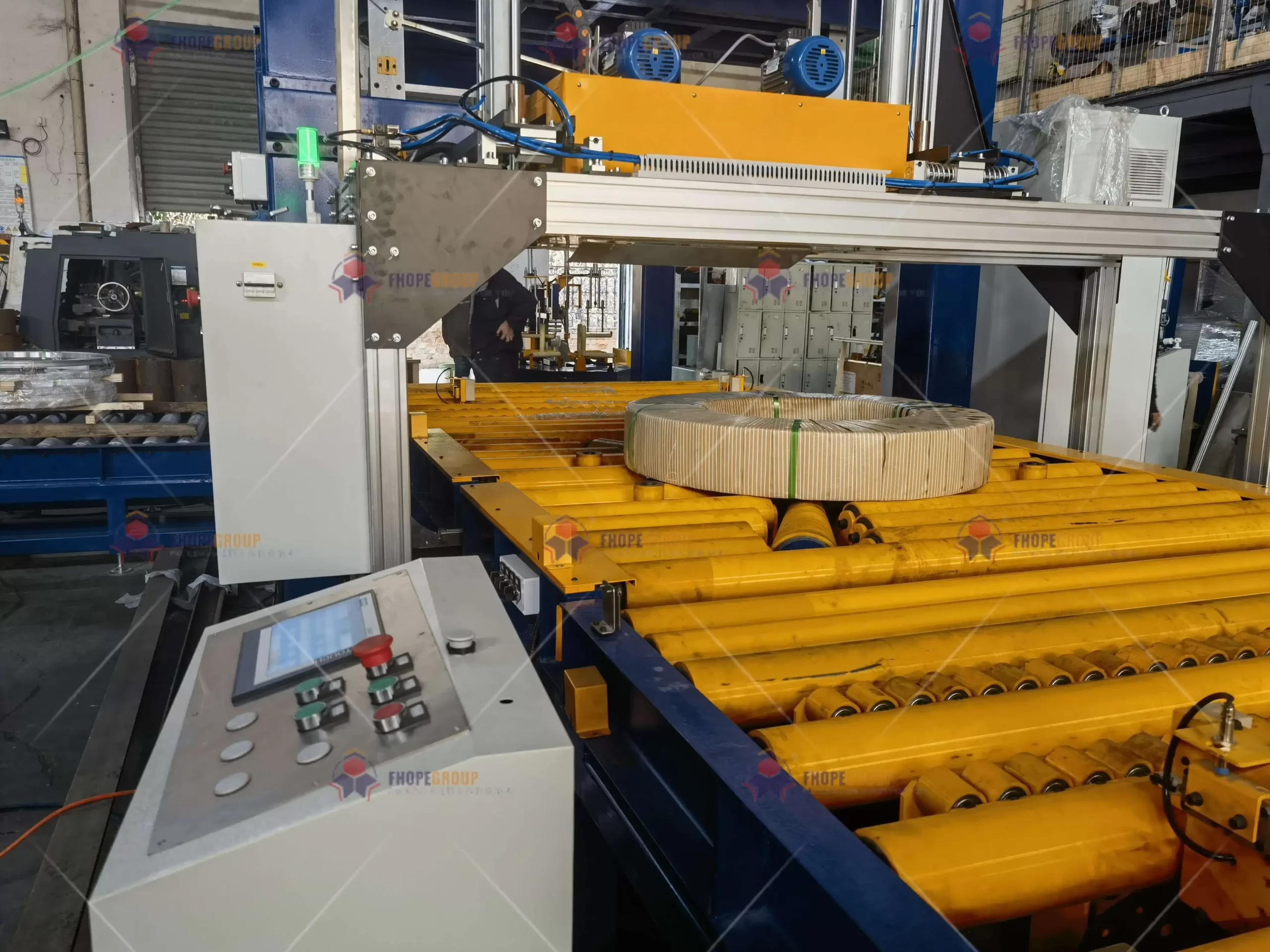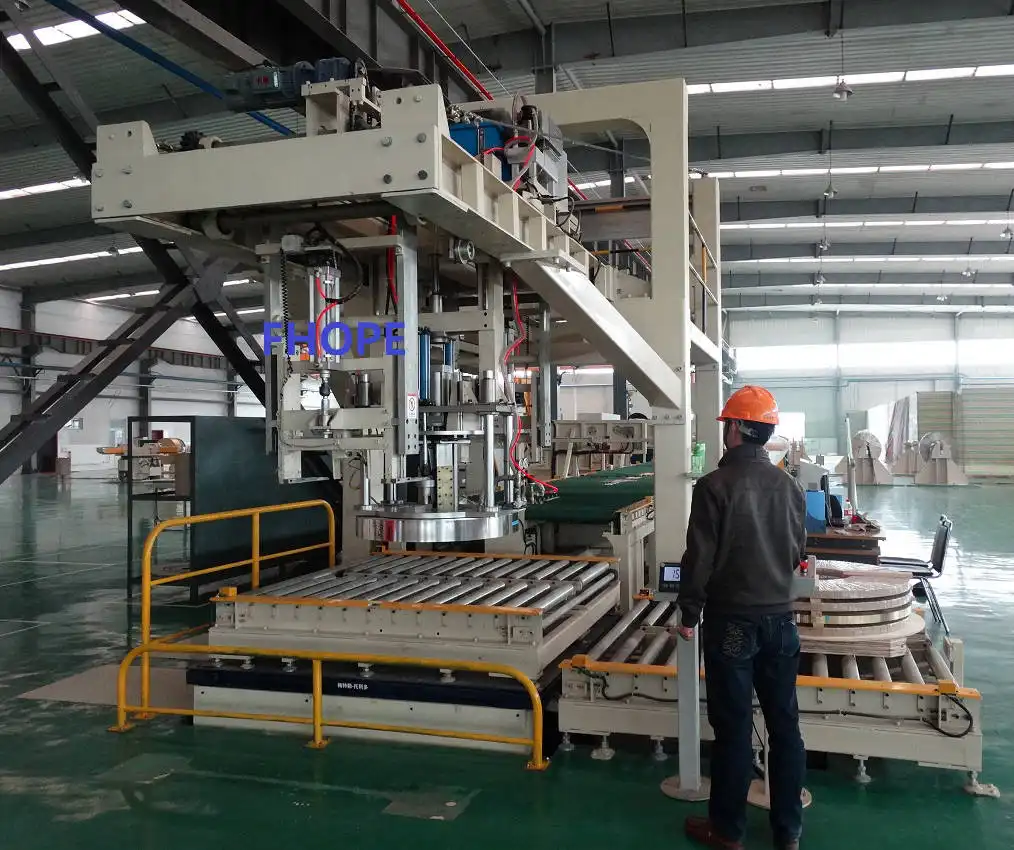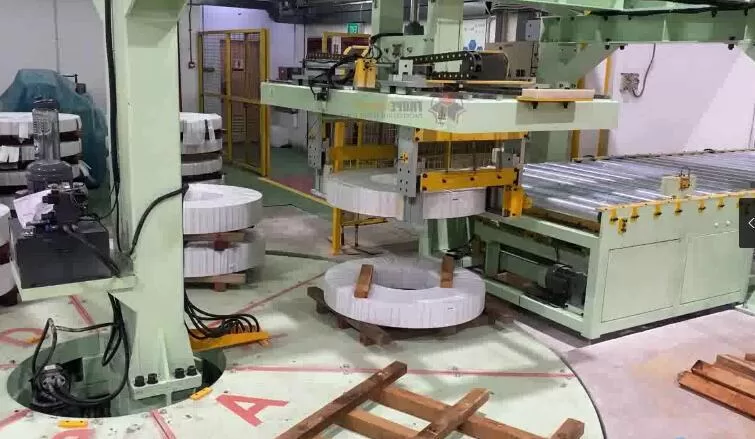Are you running a steel mill in Turkey and constantly battling rising costs and aging equipment? You know that every minute of downtime and every damaged coil eats directly into your profits. The pressure to stay competitive is immense, and finding reliable solutions feels like a constant struggle. But what if you could turn your end-of-line packaging from a bottleneck into your most efficient, reliable, and data-rich operation? What if there was a clear path to boosting your production, not by working harder, but by working smarter?
You can boost production in your Turkish facility by integrating smart coil wrapping and handling solutions. These systems automate the entire process, from the slitting line to the warehouse. This reduces manual labor, minimizes product damage, and significantly increases your throughput and overall efficiency. It is the most direct way to improve operational stability and lower costs in your final production stage.

This sounds good in theory, but you are a practical business owner. You need to know how this applies to your specific challenges in the Turkish market. You face fluctuating energy prices, aging machines, and the constant need for digital tools to stay ahead. You don't just need a new machine; you need a strategic solution. Let's break down exactly how these modern systems tackle your biggest problems, one by one.
How Can Integrated Coil Handling Systems Tackle Aging Equipment and Reduce Downtime?
You see it every day. A crucial piece of equipment that's over 15 years old suddenly fails. The entire production line grinds to a halt. Your team scrambles to fix it, but the delay is costly, and these breakdowns are becoming more frequent. It feels like you're constantly fighting fires, making it impossible to reach that ambitious goal of 95% equipment uptime. An integrated coil handling system offers a direct solution to this chronic problem, creating a smooth and predictable workflow where aging, standalone machines once caused chaos.
Integrated coil handling systems tackle aging equipment by replacing multiple outdated, standalone machines with a single, cohesive unit. This system automates coil transport, strapping, and wrapping, which eliminates the bottlenecks and manual errors that cause most production stops. By creating a seamless flow from the slitter to storage, it drastically reduces unscheduled downtime and helps you achieve your 95% operational uptime goal.

Dive Deeper: From Fighting Fires to Building a Fortress
When I started as a young engineer in a packing machine factory, I remember the constant stress of equipment failure. A conveyor belt would snap, or a strapping tool would jam, and the entire downstream production would stop. The factory manager was always under pressure. We were reactive, always fixing what was already broken. When I later established my own factory, I promised myself I would build a proactive system. That is the core difference an integrated system brings. It's about designing reliability from the ground up.
The Problem with Standalone Machines
Many older mills in Turkey operate with a collection of separate machines. A crane or forklift moves a coil to a manual strapping station. Then, workers move it again to a separate wrapping machine. Each transfer is a potential point of failure, delay, and product damage.
- Crane/Forklift Dependency: This creates a major bottleneck. If a crane is busy elsewhere, the entire packing line waits.
- Manual Bottlenecks: Manual strapping is slow and inconsistent. It relies on worker speed and attention, which can vary.
- Safety Risks: Moving heavy coils manually or with forklifts in a crowded area is a significant safety hazard.
- Lack of Communication: The machines don't "talk" to each other. A problem at the wrapper doesn't alert the strapping station, leading to pile-ups and chaos.
How an Integrated System Creates a Smooth Flow
An integrated system combines these separate steps into one automated, intelligent line. It's not just a collection of machines; it's a total solution.
| Component | Function | How It Reduces Downtime |
|---|---|---|
| Coil Car / Turnstile | Receives coils directly from the slitter and positions them. | Eliminates waiting time for cranes. Ensures perfect alignment. |
| Automated Strapping | Applies radial or circumferential straps automatically. | Provides fast, consistent strapping. Removes the human bottleneck. |
| Conveyor System | Smoothly transports the coil to the next station. | Creates a continuous flow. No manual handling needed. |
| Wrapping Machine | Applies protective film securely around the coil. | Runs continuously and signals when film is low, preventing stops. |
| Stacking & Down-ending | Stacks coils or prepares them for shipment. | Automates the final step, reducing forklift traffic and labor. |
This integration means the entire process is synchronized. The system knows where every coil is at all times. It is designed to run with minimal human intervention, which directly attacks the root causes of downtime—human error and mechanical failure at transfer points. This is how you move from a reactive state of fixing problems to a proactive state of stable, predictable production.
What's the Real ROI on Automated Coil Wrapping for a Turkish Steel Mill?
As a steel mill owner, you scrutinize every major investment. You look at the price tag for a new automated line and rightly ask, "Will this pay for itself?" With volatile energy costs and market demand, you cannot afford to invest in something that doesn't deliver a clear and substantial return. The pressure to lower operating costs by 8% or more is real. You're not just buying a machine; you're investing in profitability. A detailed look at the Return on Investment (ROI) shows that automation isn't a cost center, but a powerful profit driver.
The real ROI on automated coil wrapping for a Turkish steel mill comes from multiple, measurable sources. It drastically cuts labor costs by reassigning workers, reduces material waste from precise film and strap application, and prevents costly product damage during handling and transport. These combined savings often lead to a full payback period of 18-24 months, directly boosting your bottom line and helping you achieve your cost-reduction targets.

Dive Deeper: Looking Beyond the Purchase Price
When I started my own factory, I had to be extremely careful with money. I learned a valuable lesson very quickly: the cheapest machine is often the most expensive one in the long run. The real cost includes labor, materials, maintenance, and the cost of failure. A CEO like you understands this. The key is to analyze the Total Cost of Ownership (TCO) and the tangible returns an investment generates. Let’s break down the numbers for a typical Turkish steel mill.
The Hard Numbers: Where the Savings Come From
An automated system delivers savings in areas that directly impact your profit and loss statement. It's not abstract; it's cash that stays in your business.
| Cost Area | Manual / Semi-Auto Process | Fully Automated System | Tangible ROI |
|---|---|---|---|
| Labor | Requires 2-3 workers per shift for strapping, wrapping, and handling. | Requires 1 supervisor to oversee the entire line. | Reduces direct labor costs by 60-75%. Frees up skilled workers for more valuable tasks. |
| Packing Material | Inconsistent manual wrapping leads to overuse of stretch film. | Pre-stretch function stretches film by 250-300%, using less material for a stronger wrap. | Reduces film consumption by up to 50%. This is a direct, ongoing material cost saving. |
| Product Damage | Manual handling can cause scratches, dents, and moisture damage. | Full, tight, and waterproof packaging protects the coil integrity. | Eliminates costs from scrap, rework, or customer complaints. Protects your brand reputation. |
| Throughput | A manual line can process maybe 10-15 coils per hour. | An automated line can consistently process 30-40 coils per hour. | Increases your shipping capacity without adding shifts. Allows you to take on more orders. |
The Hidden Financial Gains
Beyond these direct savings, automation generates returns that are harder to quantify but just as important for a forward-thinking leader.
- Improved Safety: Automating the movement of heavy coils dramatically reduces the risk of workplace accidents. This leads to lower insurance premiums and a more stable, happier workforce.
- Enhanced Cash Flow: By increasing throughput, you can invoice customers faster. Getting products out the door more quickly shortens your order-to-cash cycle.
- Strategic Advantage: When your packaging is perfect and your delivery is reliable, you build a reputation for quality. This allows you to retain high-value customers and even command a premium in a competitive market like Turkey's.
When you combine the hard savings with these strategic benefits, the ROI of an automated coil packing line becomes undeniable. It's a foundational investment for achieving your goal of an 8% reduction in overall operating costs.
How Do Modern Coil Packing Lines Support Digital Transformation and Data-Driven Decisions?
You have a strategic goal to push your mill toward a digital future. You've heard the terms: MES, IoT, Big Data. But how does a piece of heavy machinery like a packing line fit into this high-tech vision? You don't want another "dumb" machine that sits isolated on the factory floor. You need equipment that can communicate, that can provide you with the real-time data needed to make smart, informed decisions and achieve full production visibility. Modern coil packing lines are designed to be exactly that: a key data source for your smart factory.
Modern coil packing lines support digital transformation by acting as intelligent data collection points on your production floor. They are equipped with advanced sensors and PLCs that integrate seamlessly with your Manufacturing Execution System (MES) and ERP. They provide a constant stream of real-time data on production counts, cycle times, material consumption, and machine health, turning raw operations into actionable business intelligence.

Dive Deeper: Your Packing Line as a Data Hub
I've been in this industry long enough to see the shift from pure mechanics to mechatronics. Today, the control system and the data it produces are just as important as the steel frame of the machine itself. A modern packing line is no longer just a wrapper; it's an information gateway. For a leader focused on digitalization, this is where the true value lies. It connects the physical world of your factory to the digital strategy of your boardroom.
Turning Actions into Data Points
A smart packing line is covered in sensors that translate physical actions into digital data. This information is precise, automatic, and available in real time.
- Production Output: It logs every coil that is wrapped, stamped with a timestamp. You get exact counts per shift, per day, per week.
- Cycle Time: It measures the exact time it takes to process each coil. This helps you identify inefficiencies and benchmark performance.
- Material Consumption: It tracks exactly how much stretch film and how many straps are used for each coil.
- Downtime & Alarms: When the machine stops, it logs the reason. "E-Stop pressed," "Film roll needs changing," or "Motor overload." This tells you why you have downtime, not just that you have it.
Integration with MES/ERP: The Complete Picture
This data is powerful on its own, but its true value is unlocked when it's integrated with your other business systems.
- ERP to MES: Your ERP system sends a production order to the MES. The MES knows that Coil ID #AB-123 needs to be processed.
- MES to Packing Line: The MES communicates this to the packing line's PLC (Programmable Logic Controller). The line can even receive specific packing "recipes" for different customers.
- Packing Line to MES: As Coil ID #AB-123 is processed, the packing line sends all the data points (cycle time, materials used, completion time) back to the MES.
- MES to ERP: The MES updates the production order as complete, and this information flows back to the ERP for inventory and billing.
You now have a complete digital history for every single coil that leaves your facility. This is the foundation of comprehensive production visualization.
From Data to Better Decisions
With this data, you can move from guessing to knowing.
| If the Data Shows... | You Can Make This Decision... |
|---|---|
| Cycle time is 15% slower on the night shift. | Investigate and provide targeted training for the night shift crew. |
| Machine #3 is using 10% more film than others. | Schedule predictive maintenance to check the pre-stretch unit calibration. |
| The most common alarm is "Safety Gate Opened." | Review operator workflow and safety protocols in that area. |
This is what data-driven decision-making looks like on the factory floor. It allows you to fine-tune your operations, predict problems before they happen, and find hidden opportunities for efficiency gains, all key steps in your digital transformation journey.
Can Smart Wrapping Solutions Also Help Meet Turkey's Growing Environmental Standards?
As a responsible business leader in Turkey, you are facing increasing pressure from the government and the public to improve your environmental performance. Stricter emissions standards and a focus on sustainability are no longer optional. You might worry that compliance is just another cost—a heavy investment in new technology that hurts your bottom line. However, when it comes to packaging, the opposite is often true. Smart wrapping solutions are inherently designed for efficiency, and that efficiency directly translates into a smaller environmental footprint and lower costs.
Yes, smart wrapping solutions can significantly help you meet growing environmental standards. They achieve this primarily by minimizing waste. Advanced pre-stretch systems can reduce plastic film consumption by over 50%, while modern, energy-efficient motors and drives lower electricity usage. This dual benefit allows you to reduce your environmental impact while simultaneously cutting material and energy costs.

Dive Deeper: Good Engineering is Green Engineering
Throughout my career as an engineer and a factory owner, I've held a core belief: good design is efficient design. An efficient machine uses less material, less energy, and less time to do its job. It turns out that the principles that make a business more profitable are often the same ones that make it more sustainable. For a steel mill looking to reduce both its costs and its carbon footprint, modernizing the packing line is a win-win.
The Power of "Less is More": Reducing Material Waste
The single biggest environmental benefit comes from reducing the consumption of packing materials, especially plastic stretch film.
- Old Technology: Older wrappers simply wrap film around a coil. To make it secure, operators often have to use many layers, which is wasteful and time-consuming.
- Modern Pre-Stretch Technology: A modern wrapping machine includes a pre-stretch carriage. This is a set of rollers that stretches the film by 250% to 300% before it's applied to the coil. Think of stretching a rubber band; it gets thinner but also stronger and holds tighter.
The impact is massive. A roll of film that would wrap 10 coils on an old machine can now wrap 25 or 30 coils. This isn't a small improvement; you are literally cutting your plastic film consumption in half, or even more. This drastically reduces your plastic waste and your material purchasing costs.
Slashing Energy Consumption
Your concern about volatile energy costs in Turkey is valid. Modern packing lines are designed to address this head-on, which also benefits the environment.
| Feature | Old Machines | Modern Machines | Environmental & Cost Impact |
|---|---|---|---|
| Main Motors | Often oversized and run at a constant, high speed. | Use high-efficiency motors with Variable Frequency Drives (VFDs). | VFDs adjust motor speed to the exact power needed, reducing electricity consumption by 20-40%. |
| System Idle | Continue to draw significant power even when not wrapping. | Enter a low-power "sleep" mode automatically after a period of inactivity. | Slashes phantom energy waste during production gaps. |
| Pneumatics | Heavily reliant on compressed air, which is inefficient and prone to leaks. | Use electric actuators for many movements instead of air cylinders. | Reduces the load on your air compressors, a major source of energy use in any factory. |
By using less material and less energy for every coil you ship, a smart wrapping solution is a practical tool that helps you meet your environmental goals, satisfy regulators, and achieve your goal of reducing unit product energy consumption. It proves that productive and profitable manufacturing can and should be sustainable.
Conclusion
Smart coil handling is not an expense; it's a strategic investment in efficiency, data, and future growth for your Turkish mill. Let's build that future together.





